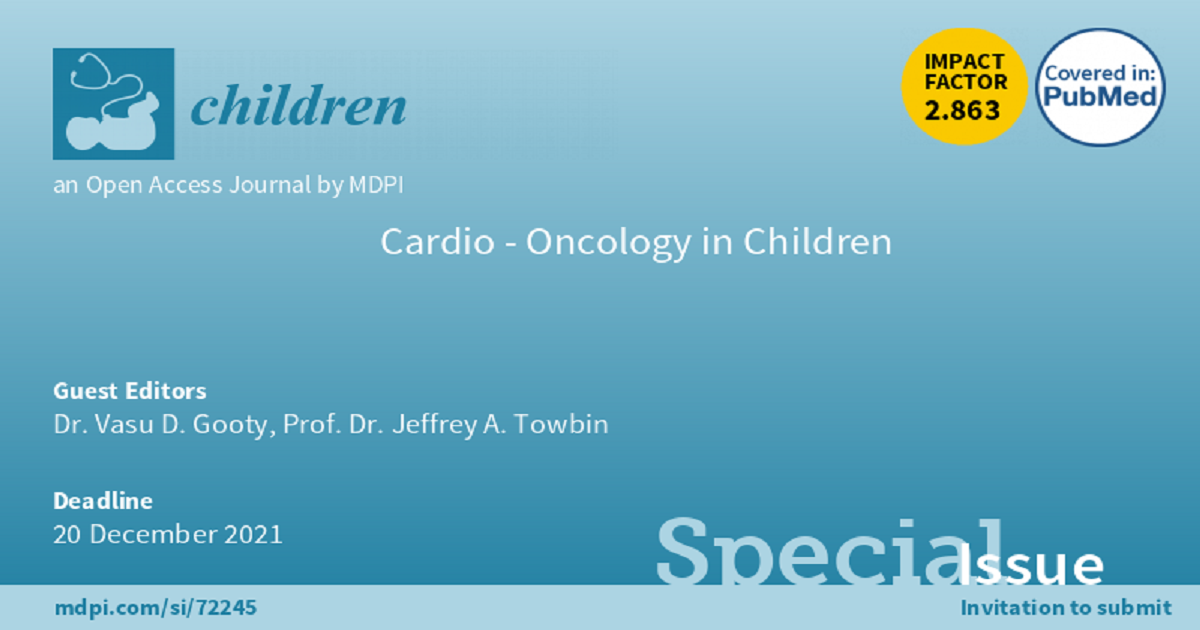Cardio-Oncology in Children
A special issue of Children (ISSN 2227-9067). This special issue belongs to the section "Pediatric Hematology & Oncology".
Deadline for manuscript submissions: closed (20 December 2021) | Viewed by 15846

Special Issue Editors
Interests: pediatric cardiology; pediatric echocardiography; cardiac MRI and cTA; pediatric cardio-oncology; machine learning and artificial intelligence; multisystem inflammatory syndrome in children—MIS-C
Interests: diagnostic and therapeutic advances for cardiomyopathies; heart failure and heart transplantation; cardiovascular genetics; cardio-oncology
Special Issues, Collections and Topics in MDPI journals
Special Issue Information
Dear Colleagues,
It is with great pleasure that we invite you to collaborate and contribute to this Special Issue on “Cardio-Oncology in Children”. With rapid advancement in the treatment of pediatric cancer, the overall mortality from cancer has been drastically reduced. However, there is increased recognition of cardiovascular toxicity secondary to standard and new cancer therapeutic agents that leads to heart failure and associated complications. The incidence and prevalence of cardiotoxicity is seen as early as during the initial stages of therapy and as late as years after completing therapy, a group known as long-term survivors of childhood cancers. This can lead to significant morbidity and mortality from cardiovascular complications. Several surveillance and treatment guidelines for the management of these patients have been published in the last 5–10 years; however, most of this literature is based on expert opinion, observational studies in children and limited robust clinical trials.
In this Special Issue, we envision providing a broad perspective in the field of pediatric cardio-oncology and hope to shed light on critical unanswered questions surrounding the cardiovascular care of children with cancer with topics ranging from pathophysiology to the management of these children and future trends and goals. We invite authors to submit a topic-based manuscript that provides readers with an overview of the current state and future of pediatric cardio-oncology. Please consider participating.
We look forward to hearing from you regarding your potential contribution.
Dr. Vasu D. Gooty
Prof. Dr. Jeffrey A. Towbin
Guest Editors
Manuscript Submission Information
Manuscripts should be submitted online at www.mdpi.com by registering and logging in to this website. Once you are registered, click here to go to the submission form. Manuscripts can be submitted until the deadline. All submissions that pass pre-check are peer-reviewed. Accepted papers will be published continuously in the journal (as soon as accepted) and will be listed together on the special issue website. Research articles, review articles as well as short communications are invited. For planned papers, a title and short abstract (about 100 words) can be sent to the Editorial Office for announcement on this website.
Submitted manuscripts should not have been published previously, nor be under consideration for publication elsewhere (except conference proceedings papers). All manuscripts are thoroughly refereed through a single-blind peer-review process. A guide for authors and other relevant information for submission of manuscripts is available on the Instructions for Authors page. Children is an international peer-reviewed open access monthly journal published by MDPI.
Please visit the Instructions for Authors page before submitting a manuscript. The Article Processing Charge (APC) for publication in this open access journal is 2400 CHF (Swiss Francs). Submitted papers should be well formatted and use good English. Authors may use MDPI's English editing service prior to publication or during author revisions.
Keywords
- cardio-oncology
- heart failure
- cancer
- cardiomyopathy
- cardiotoxicity
- chemotherapy
Benefits of Publishing in a Special Issue
- Ease of navigation: Grouping papers by topic helps scholars navigate broad scope journals more efficiently.
- Greater discoverability: Special Issues support the reach and impact of scientific research. Articles in Special Issues are more discoverable and cited more frequently.
- Expansion of research network: Special Issues facilitate connections among authors, fostering scientific collaborations.
- External promotion: Articles in Special Issues are often promoted through the journal's social media, increasing their visibility.
- e-Book format: Special Issues with more than 10 articles can be published as dedicated e-books, ensuring wide and rapid dissemination.
Further information on MDPI's Special Issue polices can be found here.







